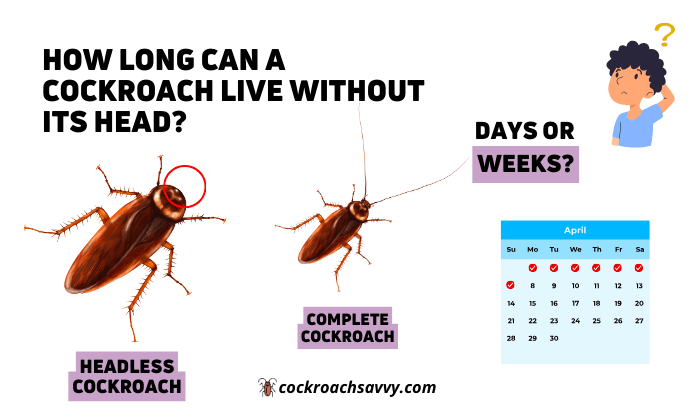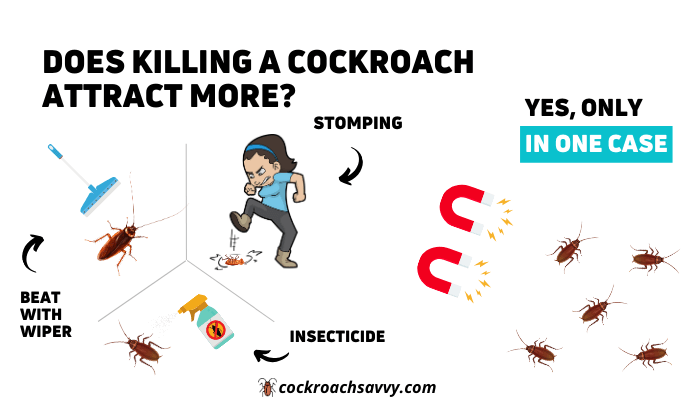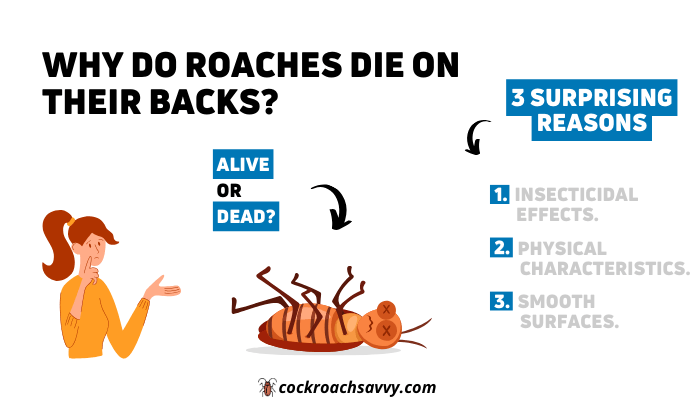Hello, I want to reassure you: the last time you saw a cockroach moving hours after losing its head, you weren’t hallucinating.
But cockroaches can’t regrow their heads as you might have read in some online discussions. The surprising truth is that these insects have an incredible ability to survive without their heads for days.
How many days exactly? This is what you’re about to know.
In this post, we’ll answer the question: How long can a cockroach live without its head? We’ll also give you the reasons behind this unbelievable ability. More interestingly, you’ll learn about other astonishing roach facts.
Let’s get started!
How Long Can Cockroaches Live Without their Head?
For Over a Week!
A decapitated roach can live for a week and sometimes longer, depending on its health condition and the last time it had food and water.
Impressive, isn’t it? But how is that?
Well, here’s a quick look at what gives these creatures that survival superpower:
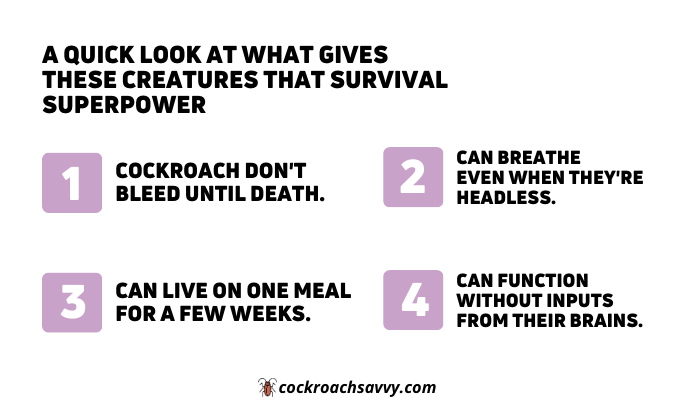
- When a cockroach’s body part is cut, they don’t bleed until death.
- These insects don’t exclusively depend on their heads to breathe. Roaches’ body cells will still receive oxygen even when they’re headless.
- Most roaches can live on one meal for a few weeks.
- Unlike humans, roaches have a decentralized nervous system, meaning they can move and function without inputs from their brains.
However, a headless cockroach will eventually die of thirst after a week or so, as it won’t be able to consume water without their mouth.
How Can Cockroaches Survive Without a Head?
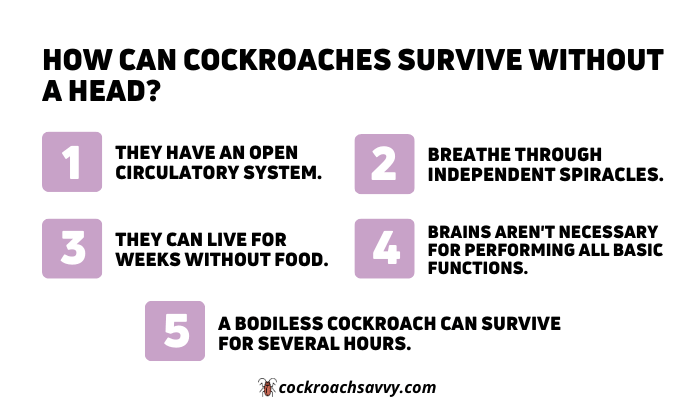
A Close Look at Their Survival Ability!
Now, please put aside everything you know about the biology of humans and most pets.
These insects have significantly different biological characteristics. Let’s dive deep into what makes these creatures super survivors:
They Have an Open Circulatory System
Cockroaches have an open circulatory system that doesn’t cause them to bleed until death if they’re decapitated. The same applies when they lose almost any body part.
In fact, they stop bleeding in a short time after losing their heads, as their blood clots, causing their neck to seal off.
They Breathe Through Independent Spiracles
Unlike humans and many animals, roaches don’t breathe through their noses or mouths.
Instead, they use spiracles to breathe – small holes connected to a network of pipes spread all over body segments.
They also don’t rely on blood to carry oxygen to different body organs. Rather, air goes directly to the body tissues through tubes known as tracheae.
This way, headless cockroaches can still receive the oxygen they need to survive.
They Can Live for Weeks Without Food
In case you don’t know, roaches are cold-blooded insects. As such, their bodies consume significantly less food compared to warm-blooded creatures.
This way, they can survive for over a week without food. Some sources even claim these insects can live for up to a month on a single meal.
Cockroach Brains Aren’t Necessary for Performing All Basic Functions
A cockroach can still perform simple functions like touching, reacting, and standing without its brain. This is due to the decentralized nervous system these creatures possess.
Here’s a simple explanation:
Cockroaches have independent nerve tissue agglomerations called ganglia in multiple body parts. These agglomerations enable them to control simple reflexes without needing brain input.
A Bodiless Cockroach Can Survive for Several Hours
A roach’s head can still move its antennas for a few hours after being separated from its body.
Nonetheless, the brain won’t function normally. This is because it requires a lot of sensory information from the body to operate properly.
Here’s the sad ending: a headless roach won’t be able to eat or drink. It’s only a few days before it starts to experience severe dehydration.
This will lead to the eventual death of the roach within a week or so.
Can a Cockroach Survive Being Cut in Half?
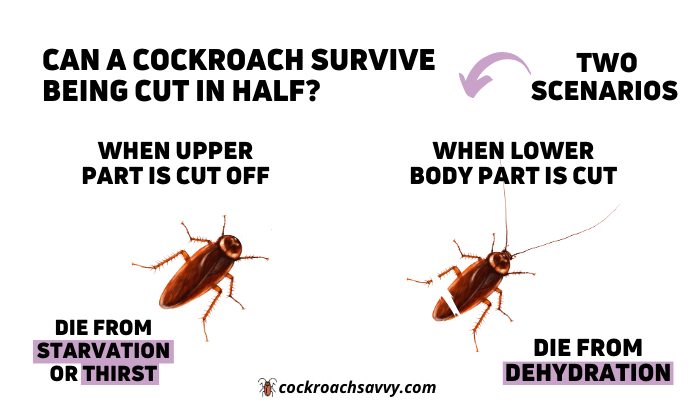
Yes, a halved cockroach can survive for up to a few days if it still has many spiracles on its body.
Let’s explore the possible scenarios when these insects lose their lower vs. upper bodies.
When the upper part is cut off, a roach won’t be able to drink or eat without a head, eventually dying from starvation or thirst.
If a roach’s lower body part is cut, it’ll lose its abdomen. As such, it’ll start losing its body water, which will eventually result in death from dehydration.
A Headless Cockroach Surviving Isn’t the Only Jaw-Dropping Fact about Roaches:

Surviving without a head is one of the cockroaches’ unbelievable survival abilities. However, this insect has a bunch of other unique characteristics.
This section will take you on a journey to discover these astonishing facts about cockroaches:
Their Speed Can Reach up to Around Three Miles per Hour
Cockroaches have an impressive moving speed that can reach 2.9 mph.
This makes these insects challenging to chase and hit. Worse still, they can spread bacteria and germs around your home quickly.
A Roach Baby’s Speed Is Almost No Different from that of Its Parents
Some sources state that a one-day-old cockroach can run as fast as an adult. The reason is the quick development of the strong legs of these insects.
Due to their massive speed and tiny size, young roaches can be hard to control using direct killing methods such as insecticide sprays.
Further, like their parents, a baby roach can spread a massive amount of bacteria and germs in no time.
A German Cockroach Can Reach Adulthood Within 36 Days
German cockroaches, one of the most common species in the US, have an incredibly rapid growth pace. They become adults in only 36 days after emerging from their eggs.
This makes the reproduction cycle of these creatures notably fast so they can invade your home in a short time.
Roaches Can Hold Their Breath for Several Minutes
The average human can hold their breath for only 30 to 90 seconds. Now, check this out: some cockroaches can hold their breath for around 40 minutes.
This is why it’s not wise to get rid of cockroaches by drowning them, as they can easily survive underwater by holding their breath too long.
The World Has Over 4,000 Cockroach Species
German and American cockroaches you see the most in the US are just two of over 4,000 roach species around the globe. Imagine the variety of physical and behavioral characteristics these insects have.
The Takeaway: A Cockroach Without a Head Can Live for Over a Week
You now know that cockroaches have super survival abilities. They can live without their head for more than a week and survive without food for up to a month. They can hold their breath for 40 minutes as well.
Hopefully, you’ve found this article helpful. If so, I’d like to invite you to explore other interesting articles on my blog. I recommend you read “How Many Cockroaches Are In The World?” next.
FAQs
Can a cockroach live without its head for 9 days?
Decapitated cockroaches can live for 9 days because of their unique survival abilities. However, they’ll eventually die due to severe dehydration as they can’t drink without their heads.
Can a cockroach regrow its head?
No, a decapitated roach can’t regrow its head. It can, however, regrow its lost limbs, according to a Chinese research study. This ability adds to their unbelievable survival capabilities.

